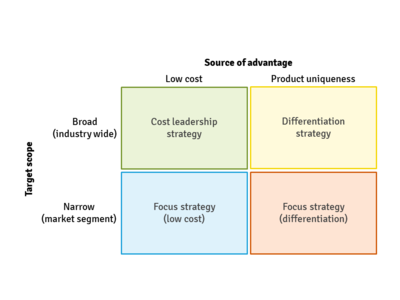Competitive position: Difference between revisions
(The LinkTitles extension automatically added links to existing pages (<a target="_blank" rel="noreferrer noopener" class="external free" href="https://github.com/bovender/LinkTitles">https://github.com/bovender/LinkTitles</a>).) |
|||
| Line 14: | Line 14: | ||
}} | }} | ||
'''Competitive position''' refers to the place of the [[company]], its products or services on the widely understood [[market]]. It describes its market share relative to all other companies acting on the market and defines the [[opportunities and threats]] that arise from it. Usually company has a significant impact on its market position. Strategies pursued by the company, ways of achieving goals and use of the [[marketing mix]] (4P - [[product]], [[price]], promotion, placement) instruments determines its competitive position in the market. It is also strongly affected by reputation, financial performance, product variety, etc. | '''Competitive position''' refers to the place of the [[company]], its products or services on the widely understood [[market]]. It describes its market share relative to all other companies acting on the market and defines the [[opportunities and threats]] that arise from it. Usually company has a significant impact on its market position. Strategies pursued by the company, ways of achieving goals and use of the [[marketing mix]] (4P - [[product]], [[price]], promotion, placement) instruments determines its competitive position in the market. It is also strongly affected by reputation, [[financial performance]], product variety, etc. | ||
==Types of competitive position== | ==Types of competitive position== | ||
Revision as of 03:17, 20 January 2023
Competitive position refers to the place of the company, its products or services on the widely understood market. It describes its market share relative to all other companies acting on the market and defines the opportunities and threats that arise from it. Usually company has a significant impact on its market position. Strategies pursued by the company, ways of achieving goals and use of the marketing mix (4P - product, price, promotion, placement) instruments determines its competitive position in the market. It is also strongly affected by reputation, financial performance, product variety, etc.
Types of competitive position
Competitive position can be classified in different ways - by a company's reputation, its financial results or by the size of the market share. Competitive position dictates the intensity and choice of strategies. If it is strong, company should apply a strong strategy in all segments of the market. If the position is weak, then company should apply a selective strategy, which is to focus on a limited number of segments and market niches..
Market leader
Creates new strategies, tries to search for and create new needs, gaining new markets - expanding its target markets, expands the existing demand, attracts new customers
Aggressive market participant
In relation to the market leader is in second or third position on the market. It is characterized by high activity in striving to increase its market share
Quiet market participant
It is a passive participant in the market, it does not care for increasing market share adapts its strategies to the emerging market conditions.
Methods of analysis of competitive positions
To maintain its competitive position, managers of company needs to constantly analyse its environment. They can use various methods, among others: strategic portfolio analysis, BCG matrix, McKinsey matrix.
See also:
References
- Brown, L. (1997). Competitive Marketing Strategy: dynamic manoeuvring for competitive position. Nelson.
- D'Aveni, R. A. (2007). Mapping your competitive position. Harvard business review, 85(11), 110-20.
- Gitlow, H. S., & Gitlow, S. J. (1987). The Deming guide to quality and competitive position. Prentice Hall Direct.
- Grant, R. M. (1991). The resource-based theory of competitive advantage: implications for strategy formulation. California management review, 33(3), 114-135.
